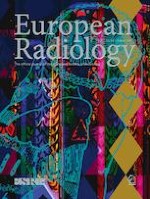Published in:

01-08-2021 | Gastrointestinal
Liver fibrosis assessment with multiphasic dual-energy CT: diagnostic performance of iodine uptake parameters
Authors:
Yasunori Nagayama, Yuki Kato, Taihei Inoue, Takeshi Nakaura, Seitaro Oda, Masafumi Kidoh, Osamu Ikeda, Toshinori Hirai
Published in:
European Radiology
|
Issue 8/2021
Login to get access
Abstract
Objectives
To evaluate the ability of iodine uptake parameters from hepatic multiphasic CT to predict liver fibrosis, and compare absolute contrast enhancement (ΔHU) with dual-energy iodine density (ID) methods.
Methods
One hundred seventeen patients with pathologically proven liver fibrosis who underwent dual-energy CT during portal-venous phase (PVP) and 3-min delayed phase (DP) between January 2017 and Octotber 2019 were retrospectively included. Two radiologists measured the hepatic and blood-pool iodine uptake using ΔHU and ID methods; extracellular volume fraction (ECV) and the iodine washout rate (IWR) calculated with both methods were compared between different fibrosis stages (F0–1 vs. F2–4, F0–2 vs. F3–4, or F0–3 vs. F4). The inter-observer reproducibility (intraclass correlation coefficients [ICCs]) for ECV and IWR was compared between the ΔHU and ID methods. The areas under the receiver operating characteristic curves (AUCs) to predict liver fibrosis severity were calculated for serum and imaging fibrosis markers. To identify independent predictors, multivariable logistic regression analysis was performed, and combined performance was assessed for the ΔHU and ID models.
Results
Patients with F ≥ 2 (n = 70), F ≥ 3 (n = 51), and F4 (n = 29) had higher ECV and lower IWR than those with F ≤ 1, F ≤ 2, and F ≤ 3, respectively (all p < 0.001). ICCs were higher in the ID method than in the ΔHU method (ECV: p = 0.045; IWR: p < 0.001). The AUC ranges of ECVΔHU, ECVID, IWRΔHU, and IWRID for predicting liver fibrosis severity were 0.65–0.71, 0.67–0.73, 0.76–0.81, and 0.81–0.85, respectively. IWR and fibrosis-4 index were independent predictors, with combined AUCs of 0.82–0.87 for the ΔHU model and 0.86–0.89 for the ID model.
Conclusions
IWR more accurately predicted liver fibrosis than ECV in routine multiphasic CT. The dual-energy ID method yielded higher inter-observer reproducibility and predictive values than the single-energy ΔHU method.
Key Points
• The IWR calculated from hepatic iodine uptake during PVP and 3-min DP predicted liver fibrosis (AUC, 0.76–0.85), while the ECV had a relatively limited predictive value (ACU, 0.65–0.73).
• Compared with the conventional ΔHU method, the dual-energy ID method provided superior inter-observer reproducibility for measurement of ECV (p = 0.046) and IWR (p < 0.001).
• The IWR and FIB-4 served as independent predictors of liver fibrosis; their combination yielded the high diagnostic performance particularly when using the ID method (combined AUCs of 0.86–0.89).